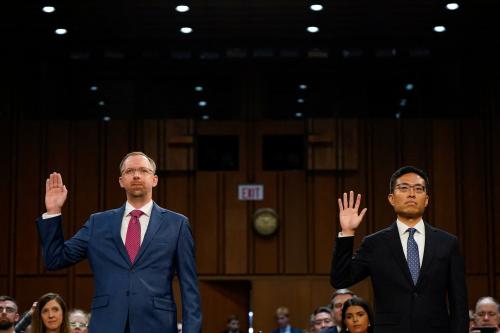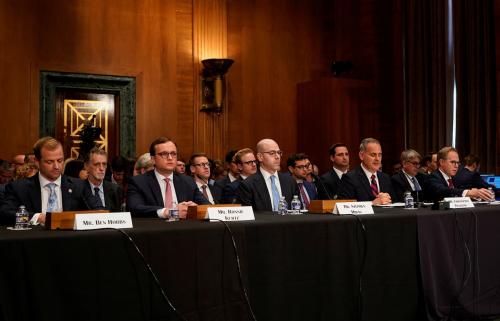Editor’s Note: As part of the 2014 Midterm Elections Series, experts across Brookings will weigh in on issues that are central to this year’s campaigns, how the candidates are engaging those topics, and what will shape policy for the next two years. In this post, Thomas Mann looks at the limited impact the elections will have on congressional-presidential relations.
Two weeks before the 2014 midterm elections (though well into early and mail balloting in some key states), how are we best to think about them? Opining about the likely winners in the Senate, House and state elections has too short a half-life; we will have the actual results on November 5 or, if runoffs are needed in Louisiana or Georgia, December 6 or January 6. The plethora of forecasting models available this year, mostly based on polls, have already absorbed too much of our attention. It’s better to focus on the likely meaning of the elections for politics and governance.
We have known for some time that the stars were aligned for a good Republican election year. A midterm election almost always produces losses for the president’s party in congressional and state elections. Those losses are magnified when, as is the case this year, the president’s approval rating is closer to 40 than 50 percent and the public feels pessimistic about the state of the economy and the future of the country. The size of the loss is also shaped by the seats at risk: This year, the third of the 100 Senate seats are up feature 21 Democrats and 15 Republicans, with 8 of the former in red states, 3 with a retiring Democratic incumbent, and 4 Democrats in purple states, while all of the Republicans except one (Maine) are in deep red states. The size of the loss is also shaped by how many House seats are competitive in terms of their underlying partisan makeup (a few dozen this round) or room for the out-party to grow its numbers (not much in 2014), and which party has more seats to defend in gubernatorial and state legislative elections (the Republicans this time around, largely because of their landslide victory in 2010). These factors operate in a context of a much smaller electorate in midterm elections (40 percent of eligible citizens) than in presidential elections (60 percent). This constitutes an additional Republican advantage this campaign year, given the turnout patterns of young and old, minorities and whites, unmarried and married.
Based on these structural factors, it was clear this past spring that Republicans had a good chance of picking up at least the six seats they need to claim the Senate majority, modestly increasing their majority in the House, and at worst losing a few net governorships and state legislative chambers. Nothing has changed during the intervening months to alter that expectation. Any significant departure from this outcome (such as Senate Democrats holding the majority by keeping their losses to five seats or less) will merit discussion of what other factors weighed in the balance: candidate quality, local and national issues or events, money, get-out-the-vote operations, a diminished party brand.
Will the 2014 midterms shed light on party prospects for 2016? Only to a limited extent. A Republican Senate victory would not materially affect their party’s prospects in the presidential sweepstakes. But a Republican upset in its quest for the Senate majority would likely relegate them to four more years in the minority, given that fewer Democratic than Republican seats are up in 2016. A stronger than expected showing by House Republicans would probably put the majority out of reach for Democrats, even if they were to have a strong presidential showing. Whatever the outcome this midterm, it is unlikely to shed much light on either party’s long term prospects.
The more immediate question is what the outcome might mean for the last two years of Obama’s presidency. In all likelihood, it will mean less than what the media attention and campaign spending might suggest. Divided party government, which in these hyper-partisan times is a formula for vehement opposition and legislative inaction, will continue (absent a totally unexpected and unprecedented pickup of a dozen and a half House seats by Democrats). The House Republican party conference will move even more to the right and be under intensified pressure to deliver for its extremely conservative base. Obama’s legislative priorities will continue to be ignored or defeated in Congress as they have since 2011.
To be sure, a Republican Senate would make life even more difficult for the President. He can expect fewer confirmations of his judicial and executive appointees, more consistently hostile congressional oversight of his administration, more obstacles to the implementation of the Affordable Care Act and the Dodd-Frank financial reform, more difficult votes for vulnerable Democratic senators, and ample opportunities to use his veto pen. But the underlying reality of presidential-congressional relations will remain the same whatever the plausible election outcome: absent a unified party government, as Obama enjoyed during his very productive first two years, his only option is to use the executive and administrative resources of his office to advance his agenda.
That doesn’t mean that the legislative harvest will be completely barren during the next two years. Obama might have success garnering approval of significant trade agreements, where support is found more among Republicans than Democrats. Funds will eventually be appropriated one way or the other to finance government operations. However perilous the journey, the debt ceiling will be raised to avoid public default. Crises like Ebola and ISIL will elicit sufficient support from Republicans to respond. A new NSA authorization balancing security and privacy concerns is possible. So too is a revised “authorization to use force.”
But if you expect comprehensive immigration reform, a major fully-funded infrastructure investment, a far-reaching tax reform, or a reauthorization of No Child Left Behind, you will be disappointed. The substantial ideological differences between the parties combined with their powerful strategic incentives to oppose the other will keep our politics and government on a dysfunctional track. Until such time as the public produces unified party government extending more than two years or the Republicans see it in their interest to do legislative business with the “enemy,” the recent past is prologue to the future.
The Brookings Institution is committed to quality, independence, and impact.
We are supported by a diverse array of funders. In line with our values and policies, each Brookings publication represents the sole views of its author(s).




Commentary
2014 Midterms: Why the Election Will Matter… and Why It Won’t
October 20, 2014